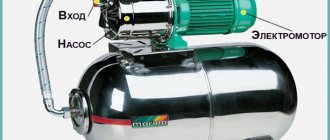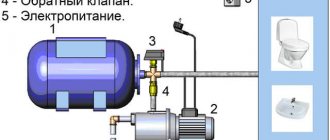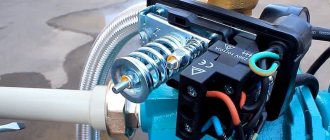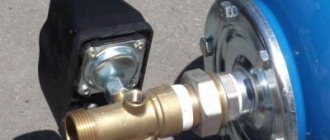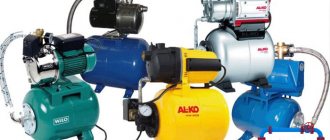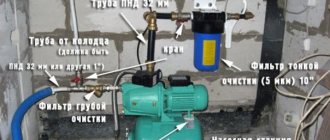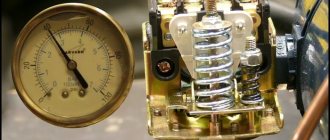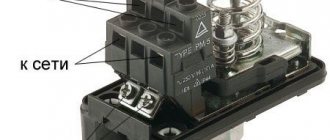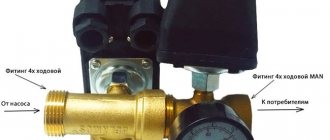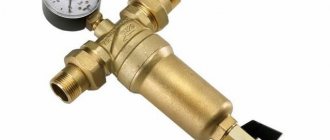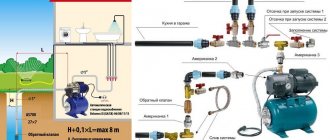Here you will learn:
- Pressure switch functions for pumping station
- Design and principle of operation of a pressure switch
- Mechanical or electronic relays
- Connecting the water pressure switch
- When to adjust the relay
- Relay settings
- Initial setup from scratch
- Situations that do not require adjustment
- What to consider when making adjustments
- Using a relay without a hydraulic accumulator
- How to choose a water pressure switch
- Popular manufacturers and prices
A pressure switch for a pumping station is a device that is used to maintain set pressure levels on pumping equipment and in the line to which it is connected.
Pressure switch functions for pumping station
The device, small in size, belongs to the group of automation systems servicing pumping equipment. Its functionality is only possible in conjunction with a hydraulic accumulator.
Despite its small size, the relay performs a number of important functions:
- allows all devices to function in the specified mode;
- Reacts sensitively to changes in on/off thresholds;
- activates and stops the pump when critical values are reached.
Simply put, it regulates the automatic pumping process of water in independent water supply schemes with a membrane tank. The adjustment is made during the switching of electrical circuits when two pressure parameters are reached in the system, accepted as the upper and lower limits.
When purchasing a pumping station, you receive a set of equipment, part of which is a pressure switch. Externally, models of different brands and series are similar, but may differ in shape, size, body color, setting method and location.
When assembling automation yourself, you need to study the characteristics of the devices and choose the most suitable ones for a particular system.
Layout of devices involved in organizing water supply to a private house from a well or borehole. The relay controls the operating pressure in the network, and the pressure gauge displays the current parameters
The devices are adapted for convenient installation and maintenance of the pumping station. Most often, they are secured with a fitting at the inlet of the hydraulic accumulator, but they can also be mounted in the pipe of the cold water system in close proximity to the device.
Design and principle of operation of a pressure switch
The design of the pumping station pressure switch is not complicated. The relay design includes the following elements.
Housing (see picture below).
- Flange for connecting the module to the system.
- A nut designed to adjust the shutdown of the device.
- A nut that regulates the compression force in the tank at which the unit will turn on.
- Terminals to which the wires coming from the pump are connected.
- Place for connecting wires from the electrical network.
- Ground terminals.
- Couplings for securing electrical cables.
There is a metal cover on the bottom of the relay. If you open it, you can see the membrane and piston.
The operating principle of the pressure switch is as follows. When the compression force in the hydraulic tank chamber intended for air increases, the relay membrane bends and acts on the piston. It starts to move and activates the relay contact group. The contact group, which has 2 hinges, depending on the position of the piston, either closes or opens the contacts through which the pump is powered. As a result, when the contacts are closed, the equipment starts, and when they open, the unit stops.
Water station repair yourself
- 1 Do-it-yourself water station repair
- 2 Water station repair yourself
- 3 Repair of a pumping station: causes of breakdown, how to disassemble it yourself
- 4 Do-it-yourself pumping station repair step by step
Do-it-yourself repair of a pumping station is one of the best options for getting out of a situation when some problems arise in it. Today, the water supply equipment market is oversaturated with offers for every taste. Two water supply systems have positive reviews of reliability - the Marina pumping station and the Gileks station, the structure of which is identical.
What does the pumping station consist of?
Owners of their own water supply system on the territory of a private house or cottage often encounter various types of malfunctions. Basically, pumping stations contain the following elements:
- water pump;
- hydraulic accumulator;
- relay;
- pressure gauge
The main task of a water pump is to draw water from the desired source. Surface pumps installed either in special rooms of the house or in caissons adapted for this purpose are popular among consumers. The pump must have sufficient power to lift water from the well, move it to the house and raise it to the upper water point of the house.
An important component is a hydraulic accumulator (storage tank) with a capacity of 20 liters or more. A hydraulic accumulator is a metal container whose task is to maintain constant pressure in the station’s pipelines. A successful battery model in the form of a metal cylinder with a rubber membrane inside. The membrane stretches and returns to its previous position depending on whether the pumping station is working or not.
Mechanical or electronic relays
Water pressure switches for the pump come in two varieties: mechanical and electronic. Mechanical models are much cheaper, so preference, as a rule, is given to them, and electronic ones with convenient automation, although easier to use, are less popular.
If there is a risk of emptying the water source during liquid pumping, the mechanical pressure switch is simply supplemented with an automation unit. However, there are also pointer instruments that are used exclusively with a pump. They reduce the number of equipment starts and stop the pump if the water flow stops. Timely shutdown of the equipment protects the motor from serious damage.
In addition, the mechanical design is capable of maintaining a comfortable pressure in the system. The main characteristic of such a device is the nominal operating pressure, which varies between 1.5-6.0 bar.
However, electronic devices have several significant advantages:
- Constantly adjusting the pressure of the pumping station by tightening the springs is a thing of the past. There is no need to configure and adjust the electronic pressure switch after installation.
- Installing the electronic device is very simple. Even a beginner without special skills or special education can handle this task.
- The service life is almost the same as that of a durable mechanical model.
The cost of an electronic pressure control device is 2,000-4,000 rubles. If you spend a little time visiting several sales points, you can purchase a high-quality device at a fair price. It’s also not worth saving much, since there is a high probability that a cheap mechanism will quickly fail.
Connecting the water pressure switch
The water pressure switch for the pump is connected to two systems at once: electricity and water supply. It is installed permanently, since there is no need to move the device.
Electrical part
To connect a pressure switch, a dedicated line is not required, but is desirable - there is a greater chance that the device will work longer. A cable with a solid copper core with a cross-section of at least 2.5 square meters must run from the shield. mm. It is advisable to install a combination of automatic + RCD or difavtomat. The parameters are selected based on current and depend more on the characteristics of the pump, since the water pressure switch consumes very little current. The circuit must have grounding - the combination of water and electricity creates a zone of increased danger.
Connection diagram of the water pressure switch to the electrical panel
The cables are inserted into special inputs on the back of the case. Under the cover there is a terminal block. It has three pairs of contacts:
- grounding - the corresponding conductors coming from the panel and from the pump are connected;
- line or “line” terminals - for connecting the phase and neutral wires from the panel;
- terminals for similar wires from the pump (usually on the block located above).
Location of terminals on the water pressure switch housing
The connection is standard - the conductors are stripped of insulation, inserted into the connector, and tightened with a clamping bolt. By pulling the conductor, check whether it is securely clamped. After 30-60 minutes, the bolts can be tightened, since copper is a soft material and the contact may weaken.
Pipeline connection
There are different ways to connect a water pressure switch to the plumbing system. The most convenient option is to install a special adapter with all the required outputs - a five-pin fitting. The same system can be assembled from other fittings, it’s just that it’s always easier to use a ready-made version.
It is screwed onto the pipe on the back of the housing; a hydraulic accumulator, a supply hose from the pump and a line that goes into the house are connected to the other outputs. You can also install a mud pan and a pressure gauge.
An example of tying a pressure switch for a pump
A pressure gauge is a necessary thing - to monitor the pressure in the system, monitor the relay settings. A mud trap is also a necessary device, but it can be installed separately on the pipeline from the pump. In general, a whole system of filters for water purification is desirable.
With this scheme, at high flow rates, water is supplied directly to the system - bypassing the hydraulic accumulator. It begins to fill after all the taps in the house are closed.
Common problems and solutions
Without a properly functioning water supply, you can’t even dream of a comfortable life in a private home; it’s not for nothing that the water supply system is called vital.
There are several symptoms that indicate that individual elements of the pumping station need repair.
The shaft rotates, but the pressure in the system does not increase
Possible reasons:
- The pump cannot develop sufficient power due to a decrease in voltage in the electrical network. To prevent such situations, you should choose a unit with a power reserve.
- There are leaks in the water supply system: a pipe may have burst or a threaded connection has depressurized. It is necessary to locate the accident site and eliminate the malfunction. A burst pipe should be replaced, a poor-quality threaded connection should be sealed by wrapping more tow or fum tape around the threads.
- Water does not enter the pipeline: check if there is water in the pump and suction line. If not, pour water through a special hole in the pump housing. If the water leaves without stopping, it means that the check valve on the suction pipeline has broken down. Perhaps nothing bad happened, and the valve was simply clogged with sand or long-fiber inclusions. If any of its parts fails, it will have to be replaced.
You should also check whether the water level at the source has dropped too much. If suspicions are confirmed, you need to lower the suction hose as low as possible. By the way, it would also be worth checking his condition. If there are cracks or gaps in the connections, air may leak into the suction line, causing the pump to stop pumping water.
If the pump and suction line are still filled with water, then it’s time to replace the worn impeller or housing. During operation, they are gradually erased by numerous solid particles moving at high speed.
If you wind too much sealing material, the latter may burst when screwing on a nut or fitting. To avoid this, the number of strands of sanitary flax or tow should be increased gradually, each time checking the tightness of the connection. This should be done until you learn to determine the required volume of sealant by eye.
The pressure on the pressure gauge jumps, and the water flows in jerks
If the pressure gauge needle, having barely reached the maximum mark, immediately begins to slide, forcing the pump to turn on again and again, the cause must be sought in the following phenomena:
- Leaks appeared in the pipeline. We have already talked about this in the previous section.
- Cracks and gaps appeared in the suction line.
- If the pump “grabs” air, water will also be supplied unevenly. Gaps must be identified and repaired.
- The operation of the hydraulic accumulator is disrupted: the first thing to do is to press the valve of the spool designed for pumping air with your finger. If water comes out of the hole, it means the rubber balloon or membrane is leaking. This part needs to be replaced. In the case of a cylinder, replacement is very simple, but some types of membranes can only be replaced by specialists. If air escapes from the spool, as it should, with a hiss, you need to check its pressure by draining the water from the accumulator.
Normally, the pressure should be approximately 1.5 atm, a more accurate value is 90% of the pump start pressure. Both too low pressure and too high lead to the same consequences: the pump starts to turn on every minute, and water flows from the tap in a pulsating stream. Most often, the air in the accumulator has to be pumped up, for which a regular car pump is used. A short time after pumping, check the pressure again.
If it fell, the problem may be as follows:
- the spool valve is clogged and cannot close completely: the spool must be blown out;
- depressurization of the housing has occurred: the hydraulic accumulator must be taken to a service center, although some craftsmen also repair them at home using “cold welding”.
During operation of the hydraulic tank, that part of it that is connected to the water supply is gradually filled with air released from the water. To prevent the tank from working at half capacity, this air must be removed approximately once every 1 - 2 months - either through a valve designed for this (installed in models with a volume of over 100 l), or by emptying.
The device cannot be turned on
Possible reasons:
- The motor winding has burned out: the most obvious sign of a winding burnout is the unpleasant “chemical” smell of melted insulation. But the winding should still be tested using a tester. If the “diagnosis” is confirmed, the engine is rewinded (it is better to invite an experienced electrician for this).
- The relay contacts need cleaning.
After switching on, the pump hums, but the shaft does not rotate
Possible reasons:
- The capacitor has failed. This element should be replaced with a suitable one.
- The impeller is stuck: this phenomenon can occur after a long period of inactivity of the unit. In this case, the pump must be turned off and then try to rotate the impeller by hand. We supply power to the pump again, now everything should work.
The pump does not turn off
Possible reasons:
- Depressurization of the water supply network.
- Incorrect relay operation.
To understand how to correct the situation, you need to take a closer look at this device.
When to adjust the relay
As mentioned above, the relay automates the process of pumping liquid into the water supply system and into the expansion tank. Most often, pumping equipment purchased ready-made already has basic relay settings. But situations arise when urgent adjustment of the pressure of the pumping station is required. You will have to perform these actions in cases where:
- after starting the pump motor, it immediately turns off;
- after the station is turned off, there is a weak pressure in the system;
- when the station is operating, an excessive compression force is created in the hydraulic tank, as evidenced by the readings of the pressure gauge, but the device does not turn off;
- The pressure switch does not work and the pump does not turn on.
Most often, if the unit exhibits the above symptoms, then relay repair is not required. You just need to configure this module correctly.
Relay settings
The manufacturer ensures that pumping stations are set to average values:
- lower level – 1.5-1.8 bar;
- upper level – 2.4-3 bar.
Lower pressure threshold
If the consumer is not satisfied with these values, then knowing how to adjust the pressure in the pumping station, they can be changed. Having figured out how to set the correct pressure in the storage tank, we begin to adjust the sensor settings:
- The pump and relay are disconnected from power. All fluid is drained from the system. The pressure gauge is at zero at this moment.
- The plastic cover of the sensor is removed using a screwdriver.
- Turn on the pump and record the pressure gauge readings at the time the equipment is turned off. This indicator is the upper pressure of the system.
- The tap furthest from the unit opens. The water gradually drains and the pump turns on again. At this moment, the lower pressure is determined by the pressure gauge. The pressure difference to which the equipment is currently set is calculated mathematically - by subtracting the results obtained.
Attention. To obtain the correct setting, you need a reliable pressure gauge whose readings you can trust.
Having the opportunity to estimate the pressure from the tap, select the required setting. Adjustment to increase the pressure of the pumping station is carried out by tightening the nut on a large spring. If the pressure needs to be reduced, the nut is loosened. Do not forget that adjustment work is carried out after disconnecting the device from the power supply.
Attention. The setting is carried out carefully; the relay is a sensitive device. One turn of the nut changes the pressure by 0.6-0.8 atmospheres.
Upper pressure threshold
To set the optimal frequency of pump activation, it is necessary to adjust the pressure difference. A small spring is responsible for this parameter. The optimal value of the difference between the upper and lower pressure thresholds is 1.4 atm. If it is necessary to increase the upper limit at which the unit turns off, then turn the nut on the small spring clockwise. When decreasing - in the opposite direction.
Setting scheme
What effect does this adjustment have on the equipment? A reading below average (1.4 atm) will ensure a uniform supply of water, but the unit will turn on frequently and quickly break down. Exceeding the optimal value promotes gentle use of the pump, but the water supply will suffer due to noticeable pressure surges. The pressure difference of the pumping station is adjusted smoothly and carefully. The result of the impact requires verification. The scheme of actions performed when setting the lower pressure level is repeated:
- All devices are disconnected from the electrical network.
- Water is drained from the system.
- The pumping equipment is turned on and the result of the adjustment is evaluated. If the performance is unsatisfactory, the procedure is repeated.
There are limitations to consider when making differential pressure settings:
- Relay parameters. You cannot set the upper pressure threshold equal to 80% of the maximum value of the device. Data on the pressure for which the controller is designed are present in the documents. Household models usually withstand up to 5 atm. If it is necessary to increase the pressure in the system above this level, it is worth buying a more powerful relay.
- Pump characteristics. Before choosing an adjustment, you must check the equipment specifications. The unit should turn off at a pressure of 0.2 atm. below its upper limit. In this case, it will function without overload.
Device selection criteria
When choosing equipment that controls the force of water flow, you should carefully study its technical characteristics.
Particular attention should be paid to the operating temperature and pressure range for which it is designed, the diameter of the threads and mounting holes, the protection class, and application nuances
It is also important to clarify what materials the product is made from.
Experts consider devices made of brass, stainless steel, and aluminum to be the most reliable and durable. These materials protect the structure from the critical consequences of a common phenomenon in water supply systems - water hammer.
Initial setup from scratch
If the springs on your relay are completely weakened, you will have to make the adjustment from scratch. In this case, the work is carried out in the following sequence:
- They start the pumping equipment and build up pressure in the system to a level where the water pressure from the tap farthest from the pump becomes more or less acceptable to you. Let's assume that the measuring device showed a value of 1.5 bar at this moment. We turn off the pump.
- Now you need to disconnect the pumping station from the power supply, open the cover on the relay and start tightening the nut on the large spring until a characteristic click is heard, indicating the contacts are closed.
- The relay cover is installed in place and the pumping equipment is started. In this case, the pressure must be increased to 2.9 bar.
- Now the unit needs to be disconnected from the power supply again, open the cover on the relay again and tighten the nut of the small spring until a click sounds when the contacts open.
- After the settings have been made, the relay will operate at a lower pressure of 1.5 bar and turn off the pump at an upper pressure of 2.9 bar. We return the cover on the relay to its place, and connect the station to the power supply.
Video instructions for adjusting the pressure switch of a water supply unit with your own hands:
Situations that do not require adjustment
There can be many reasons when the pump does not turn off or turn on - from a blockage in the communications to engine failure. Therefore, before you start disassembling the relay, you should make sure that the rest of the pumping station equipment is working properly.
If everything is fine with the other devices, the problem is in the automation. Let's move on to inspecting the pressure switch. We disconnect it from the fitting and wires, remove the cover and check two critical points: the thin pipe connecting to the system and the contact block.
To check whether the hole is clean, it is necessary to dismantle the device for inspection, and if a blockage is detected, clean it.
The quality of tap water is not ideal, so the problem is often solved by simply cleaning the inlet to remove rust and mineral deposits.
Even devices with a high degree of protection against moisture may fail due to the fact that the wire contacts are oxidized or burnt.
To clean the contacts, use a special chemical solution or the simplest option - the finest sandpaper. You need to act very carefully.
If cleaning measures did not help, and adjusting the position of the springs was also in vain, most likely the relay is no longer suitable for further use and should be replaced with a new one.
Suppose you come across an old but working device. Its adjustment occurs in the same order as setting up a new relay. Before starting work, make sure that the device is intact, disassemble it and check that all contacts and springs are in place.
What to consider when making adjustments
When planning to independently adjust the operation of the pumping station relay, you must not miss some important points:
- You cannot set the “upper” pressure, which is more than 80% of the maximum for a given relay model. It is usually indicated in the instructions or on the packaging and, most often, is 5-5.5 bar (atm.). If you need to set it to a higher level in the system of your home, then you need to select a relay with a higher maximum pressure.
- Before increasing the pump activation pressure (“upper”), it is necessary to look at its characteristics to see if it can develop such pressure. Otherwise, the pump, being unable to create it, will work without turning off, and the relay will not turn it off, because the set limit will not be reached. Typically, pump pressure is given in meters of water column. Approximately 1 m of water. Art. = 0.1 bar (atm.). In addition, it is necessary to take into account hydraulic losses in the system.
- When adjusting, you do not need to tighten the nuts of the regulators all the way - the relay may stop working altogether.
Problems with the membrane or pressure in the accumulator
Replacement membrane for hydraulic accumulator
The membrane is made of dense rubber. There could be two problems here:
- the rubber has burst and needs to be replaced;
- the pressure in the hydraulic accumulator is less than required - the rubber was subjected to excessive stretching for a long time and eventually failed.
If you press on the nipple, which is located under the plastic cover, water will flow out. This is a clear sign that the rubber has lost its integrity and the membrane will have to be changed, or the attachment point to the battery has become leaky, or the spool needs to be replaced.
The membrane can be purchased at a store in the pumping equipment department or ordered at a service center. If you need to increase the pressure in the accumulator, use a regular bicycle pump. The upper pressure that the pressure gauge shows is the sum of the water pressure in the membrane and the air pressure in the membrane tank. Together they show, for example, 2.9 atmospheres. Of this, 0.8 atmospheres will be air. While observing the pressure gauge readings with the equipment turned off, you need to pump air into the accumulator.
The relay will not switch if there are cracks in the membrane tank housing. Plastic is not the best solution for devices that need to work for a long time. If there are cracks, it is necessary to disassemble the pumping station, disconnect the tank and reassemble everything in the reverse order.
Using a relay without a hydraulic accumulator
For some equipment models, a connection diagram for a well pump with a pressure switch without a storage tank is used. A special automatic controller starts and stops the unit when the limit values are reached. The electronic unit has a dry-running protection function and ensures safe operation of the system.
Attention. The disadvantage of this scheme is the lack of a minimum water supply, which is provided by the membrane tank.
Electronic pressure switch for surface and submersible pump
The device starts the pump when the tap is opened; after stopping the water supply, the equipment works for some time to create the preset pressure level. Advantages of an automatic controller:
- compactness;
- the cost of purchasing a hydraulic accumulator is eliminated;
- stable pressure in the system.
Among the disadvantages is the frequent activation of the pump, leading to premature wear. This type of automation is suitable for a network used for long-term switching mode (watering, filling a large container).
Installation and correct adjustment of the pressure switch of the pumping station ensures stable water pressure in the system. Correct adjustment of the device helps to extend the life of the equipment and prevents the occurrence of emergency situations.
What is well automation?
Automatic control systems include electronics (pressure switch, idle speed, flow), pressure gauge, accumulator or modules in which these elements are combined - all of them are responsible for the optimal functioning of the water main.
In the water supply line, automation performs the following role:
- Controls the electric pump, turning it off as the line fills. In high-tech systems, instead of turning it off, it is used to adjust the rotation speed of the electric motor.
- Protects the water main from water hammer and helps create some water reserves in the event of equipment breakdown or power outage.
- Includes protective devices for the pump that interrupt the flow of electrical current to it in the event of a lack of water at the source.
Rice. 2 Example of a borehole water intake source
How to choose a water pressure switch
What to look for when choosing a relay:
- For autonomous water supply systems, it is worth choosing equipment for domestic use. Such devices are characterized by a maximum pressure value of no more than 5 atm, and operating pressure values usually range from 1.4 to 2.8 atm.
- When setting up the relay, you must not forget that the difference parameter between the settings on the springs directly affects the volume of liquid that the pump, with such settings, will pump into the storage tank. A large volume means that the pumping device will be turned on less often, however, the technical capabilities of the system should not be exceeded.
- It makes no sense to save too much by buying parts of unknown origin. Such equipment will not only work incorrectly, but can also cause breakdowns of other equipment.
- Installing a pressure gauge next to the relay will make it possible to observe the operating characteristics of the system and help detect violations at an early stage, when there are no external manifestations yet.
When choosing a suitable relay, you should also pay attention to such indicators as:
- connecting thread dimensions;
- level of protection against dust and moisture;
- weight and dimensions of the device;
- contact voltage;
- current ratings;
- sensor type, etc.
The pressure sensor can be installed directly on the hydraulic tank or mounted separately from it.
It should also be noted that relays are manufactured to operate in different environments. For household purposes, a mechanism designed for water is suitable. You should not purchase a relay designed to work with refrigerant or other liquids. You should also pay attention to the temperature of the working environment for a specific model.
Thus, the Plumber Portal website strongly recommends connecting a water pressure switch in all private homes, because this is an extremely useful device. The unit greatly simplifies life and makes using water supply comfortable, safe and regular.
The device will protect expensive pumping equipment from breakdowns. At the same time, you need to constantly monitor the device, promptly adjust and regulate the minimum and maximum pressure (3-4 times a year).
Main conclusion
Look for a pressure switch with an actuation ceiling that is 30 percent higher than the desired cut-off pressure in your water supply.
Pressure switch in a box
Note!
It’s really written in black and white - the pressure range is 1 - 5 atmospheres. The set value for switching on is 1.5 atmospheres, switching off is 2.8 atmospheres. It seems that the range is clearly maximum and unrealistic, but the preset pressure is exactly the one at which the relay operates reliably. Learning to read instructions. What else can I offer?
When setting the pressure, do not compress the springs too much. Significant compression of springs, especially small ones, is a factor in reducing the reliability of relay operation.
Do not make the difference between the on and off pressure too significant. For example, the switching pressure is 1.5 atmospheres and the switching pressure is 3.5 atmospheres. With such settings, the small spring will be compressed excessively. And it's already short. In this case, there is a high probability that the relay will not turn off the pump or will not do it reliably enough.
If the cut-off pressure threshold gradually increases, this is a direct sign of blockage. Water pushes the piston more slowly and with difficulty, and the relay operates with a delay. You have to wait until the pressure in the inlet assembly increases and the piston raises the platform to the desired height. In this case, we do not run for a new relay, but unscrew the old one and pick out rust from all the small holes that we find. To do this, you may have to unscrew 4 screws and remove the membrane assembly.
Thus
It seems that I don’t need to change the relays one by one, but rather go through the entire pumping station and wash it of many years of rust and hardness salts. Then I will be guaranteed another ten years of flawless pump operation and a quiet life. This is such an unexpected conclusion.
I'm glad that my words do not differ from my deeds
I re-read the article here and decided to add it. The fact is that I went through my plumbing system precisely with the goal of replacing all the hardware in it with polypropylene. There were many surprises. Read the article: Remaking a water supply system made from copper and iron.
Popular manufacturers and prices
According to consumer reviews, today the relay from the Danish company Danfoss is most popular; its pressure range is 0.2-8 bar. The cost of such equipment is about 3,000 rubles. A device from the German manufacturer Grundfos with similar characteristics already costs 4,500 rubles. Italian Italtecnica equipment with standard settings will cost about 500 rubles.
Domestic devices are almost identical to Italian ones, but their cost is about 300 rubles. Thus, domestically produced products turn out to be significantly less expensive, and in terms of their characteristics they are practically not inferior to Western models.
Experts recommend installing equipment from the same manufacturer, that is, if you purchased a German pump, then the pressure switch should be from the same manufacturer.
